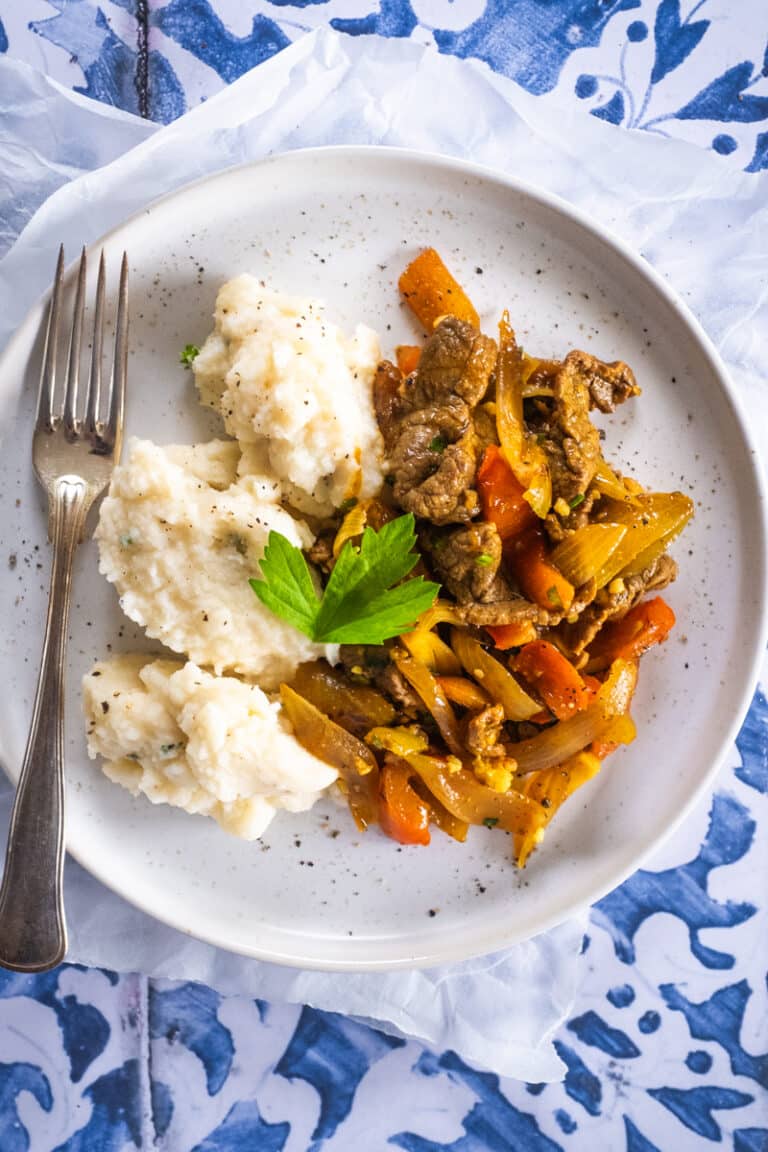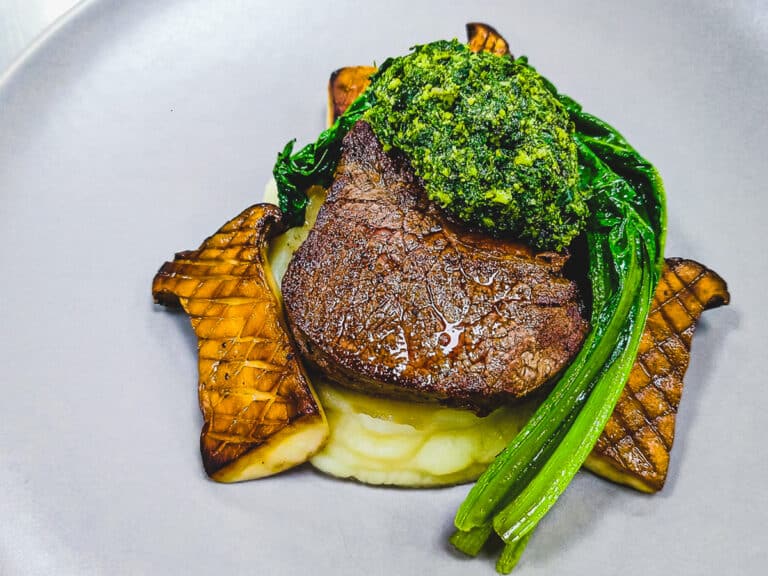Curious about what celeriac is and whether it deserves a place in your kitchen and diet? This often overlooked root vegetable, also known as celery root, is a nutritional treasure, offering a host of benefits while being low in calories.
Celeriac features a distinct, earthy flavor and is an incredibly versatile ingredient, delightful in both raw and cooked forms. Join me as we delve into the world of celeriac, exploring its myriad offerings and my favorite ways to cook this unique vegetable.
What is Celeriac?
Celery root, also known as celeriac, knob celery, or turnip-rooted celery, is a root vegetable distinct from its close relative, celery. Unlike celery, which is grown for its stalks and leaves, celeriac is cultivated for its large, edible root.
Celeriac offers a subtle, earthy flavor with slightly sweet and nutty nuances, which becomes even sweeter when cooked. Its texture is akin to root vegetables like turnips or potatoes, making it versatile in various cooking methods, including roasting, boiling, and mashing.
Gaining popularity, particularly in European cuisines, celeriac is valued for its unique taste and nutritional benefits, distinguishing it as a flavorful and healthful choice in culinary applications.
Celeriac is a cold-weather crop that reaches its peak during the cooler months of late fall and winter, typically from October through early spring, where you can find it in farmers’ markets and grocery stores.
Store celeriac in the fridge, wrapped in a damp paper towel, and in a plastic or silicon bag.
Is Celeriac the Same As Celery?
If you are thinking of planting celery or celeriac, you should know that while celeriac and celery are related and belong to the same species, they are different cultivars bred for distinct characteristics.
The seeds for each are specialized to produce either a plant with a large edible root (celeriac) or one with edible stalks and leaves (celery).

Nutritional Profile of Celeriac
Celeriac is a remarkable yet often overlooked root vegetable that boasts a wealth of nutrients while being low in calories.
Rich in essential vitamins, it provides a good amount of Vitamin K and Vitamin C, both known for their importance in overall well-being.
In addition to vitamins, celeriac is a treasure trove of minerals, including phosphorus, iron, and magnesium, all of which are essential for various bodily functions. It also contains a notable amount of potassium.
Celeriac, rich in dietary fiber and resistant starch, offers significant benefits for gut health. The resistant starch acts as a prebiotic, feeding the beneficial bacteria in the gut, essential for a healthy digestive system and a balanced microbiome.
Low in carbohydrate content, this lectin-free root vegetable is an excellent choice for those with food sensitivities, or adhering to low-carb or ketogenic diets.
What Does Celeriac Taste Like?
Celeriac’s taste profile varies slightly with different cooking methods:
Raw celeriac offers a crisp, slightly nutty texture with a flavor akin to celery and parsley, marked by a mild sweetness and a refreshing tang. It’s ideal for adding a crunchy element to salads and slaws.
When baked or sautéed, it turns richer and sweeter, developing a nutty, caramelized flavor. The texture softens to a creamy consistency, ideal for dishes where a more pronounced, earthy taste is desired.
Boiled celeriac becomes tender and milder in flavor, similar to potatoes but with an earthy undertone. This subdued sweetness and creamy texture make it perfect for purees or soups.
In each form, celeriac adapts its flavor to complement a variety of dishes, showcasing its culinary versatility.
How Do You Eat Celeriac?
Celeriac can be enjoyed in many ways, thanks to its versatile nature. This root vegetable can be consumed raw, sliced thinly, or grated into salads and slaws for a crisp, refreshing bite.
When cooked, celeriac transforms in texture and flavor. It can be roasted or baked, where its flesh becomes tender and develops a sweet, nutty taste, perfect as a side dish or a vegetarian main.
Boiled or steamed celeriac can be mashed or pureed, serving as a healthier alternative to traditional potato mash. Celeriac makes an excellent addition to soups and stews, contributing a subtle earthiness and creamy texture.
Whether raw or cooked, celeriac is typically peeled to remove its rough outer skin and can be cut into various shapes and sizes depending on the recipe requirements.
In Romania, my homeland, celeriac is a kitchen staple, always ready in the refrigerator, particularly cherished for its role in our traditional soups, but also eaten raw. The aromatics base for our soups always includes onions, carrots, celeriac, and parsnips, sometimes, if available, parsley root.

My Favorite Celeriac Recipes
I hope these recipes will inspire you to try this underrated root vegetable or prepare it in different ways.
Creamy Celeriac Puree
My kitchen also often sees the making of creamy celeriac puree, a sophisticated (but easy) twist on traditional mashed potatoes. This dish isn’t just easy to whip up; it’s a nutritious, low-carb side dish.
Mashed Cauliflower, Celeriac, and Parsnip
For more variety, I sometimes blend celeriac with cauliflower and parsnip to create a mashed mix of these three vegetables – a wholesome, low-carb side dish.
Root Vegetable Puree
There are infinite possibilities for combining real, nutritious foods to make a creamy mash. I love this blend of cauliflower, parsnip, celeriac, and sweet potato for a sweeter, grounding taste.
Cream of Celeriac, Parsnip and Cauliflower
When craving a creamy soup, my go-to is a Cream of Celeriac, Parsnip, and Cauliflower Soup. It’s wonderfully soothing and also makes an excellent choice for babies.
Creamy Celeriac Soup with Parmigiano Reggiano
Or give this elegant celeriac soup a try! It’s creamy, full of flavor, and has that perfect umami touch of the king of cheeses, Parmigiano Reggiano.
Beef Tenderloin with Celeriac Puree
For a special occasion, incorporate celery root into the menu by preparing this gourmet dinner created by my friend, Chef Adrian Bandyk: Grass-Fed Beef Tenderloin with Celeriac Puree, Chard, King Oyster Mushroom, Kale and Macadamia Pesto.
Celeriac Slaw
Another Romanian classic and a personal favorite is celeriac slaw. This delightful dish combines grated celeriac with carrots and apples, all brought together with homemade mayonnaise and generously seasoned with salt and black pepper.
It’s a refreshing, sweet, and earthy side that complements any meal beautifully. You will find this recipe on my Substack (available for subscribers).
Roasted Celeriac (Hasselback) with Garlic-Butter Sauce
Tender, sweet, and earthy, roasted celeriac transforms this humble root vegetable into a show-stopping side dish. With just a handful of simple ingredients, this low-calorie, low-carb Hasselback celeriac is as easy to make as it is impressive to serve.
Other Creative Ways to Prepare It
And then there are celeriac steaks or roasted celeriac – a unique preparation where celeriac is peeled, sliced into half-inch rounds, seasoned with salt, pepper, and black garlic powder, and baked at 200°F until fork-tender and golden brown. Flipping them halfway ensures a nice color on both sides.
While they make a great side dish, my favorite way to serve them is as a burger bun alternative. The mix of flavors and textures here is simply sublime. For a glimpse into how these are made, check out the video on my Instagram account.
Lastly, I’m intrigued by a concept I’ve yet to try: celeriac rice or celeriac risotto. The idea is to process raw celeriac in a food processor until it resembles rice, then cook it as you would cauliflower rice. This low-carb side dish seems promising, and I’m excited to experiment with it!
In Conclusion
Celeriac can easily transcend its status as an obscure vegetable to become a versatile, nutritious, and flavorful staple in any kitchen. With its unique taste and numerous health benefits, it caters to a broad spectrum of culinary preferences.
Embrace the versatility of celeriac in your cooking adventures, whether it’s in healthy soups, low-carb purees, crunchy salads, or even as a creative, low-carb alternative to burger buns. The possibilities with celeriac are indeed limitless.
If you, like me, love exploring new ingredients, celeriac is bound to be a delightful discovery.
*This post contains affiliated links, which means I get a small commission if you choose to purchase something via one of my links, at no extra cost to you.









0